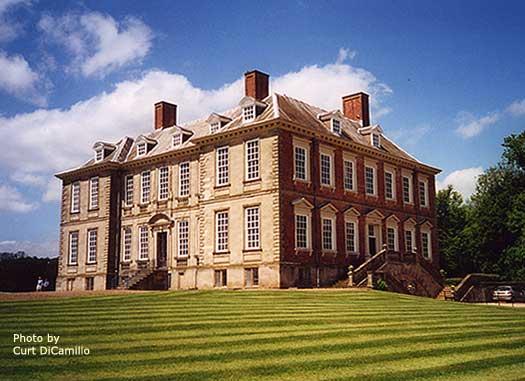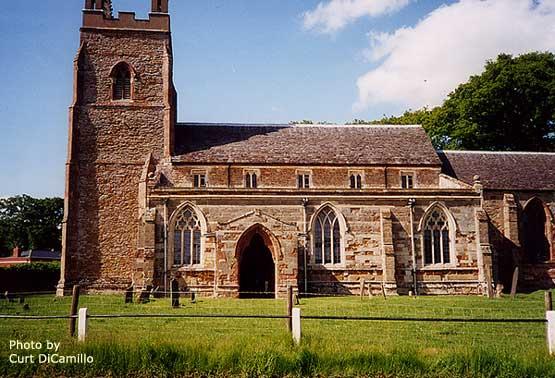
The Entrance and Side Facades

The House and Stables

The Rear Facade

The Church of St. Nicholas
Earlier Houses: An earlier manor house was demolished in 1690.
Built / Designed For: Sir Roger Cave
House & Family History: The land of Stanford was granted to the Benedictine Abbey of Selby in Yorkshire by Wide de Reinbuedcurt in 1069. A second grant of Stanford land was made to the Abbey by King Stephen in 1140 (the land grant from King Stephen is still in the Library at Stanford today). In 1540, after the Dissolution of the Monasteries, Sir Thomas Cave bought the Manor of Stanford from Henry VIII for £1,194, approximately £6.7 million in 2016 inflation-adjusted values using the labour value commodity index. In the 1690s Sir Roger Cave commissioned the Smiths of Warwick to demolish the old manor house and create the current House on higher ground. The design of Stanford was influenced by Clarendon House, built between 1664 and 1667 to the designs of Sir Roger Pratt for the Lord Chancellor, Edward Hyde, 1st Earl of Clarendon. (Clarendon House was a palace situated at the top of St. James's Street in the Piccadilly section of London; yet for all its grandeur, it had a short life, being demolished in 1684, one year after Lord Clarendon's death.) Sarah, Baroness Braye, added to the collection of Stanford considerably when she was in Rome, circa 1807, during the sale of the possessions of Henry, Cardinal Duke of York, the last of the royal Stuarts. During the 1890s the 5th Lord Braye installed electricity in Stanford; he was keen to do the wiring without damaging the floorboards and arrived at the ingenious solution of making two holes at opposite ends of the room, tying one end around the collar of a ferret and placing the ferret in one of the holes; at the other hole was the flesh of a rabbit. This method was a great success and was repeated until the entire House was wired. Queen Mary, George VI, and the Duke of Windsor have all been visitors at Stanford Hall. During World War II the family left Stanford for the first time in its history and the House was occupied by the Convent of the Sacred Heart, a girls' school that had been bombed out of their facility in Roehampton. The star of Stanford Hall, the pink and gold Ballroom, has a coved ceiling with four trompe l'oeil shell corners.
Collections: Stanford contains a fine Library of over 500 books that holds, among other treasures, an eyewitness account of the execution of Charles I and a speech by Francis Bacon in the House of Commons. The oldest manuscript in the Library dates from 1150. Stanford also contains a collection of royal Stuart portraits that once belonged to Henry, Cardinal Duke of York, the last of the male royal Stuarts.
Chapel & Church: The Roman Catholic Chapel of St. Thomas of Canterbury was created by the 6th Lord Braye from one of the old outbuildings on the Estate. The Norman Church of St. Nicholas is in the southeast corner of Stanford Park and has fine old stained glass and well preserved monuments. The Church was defended successfully during the Civil War by the Cave family and the villagers, who were summoned by the ringing of the Church bells. The oak altar table is the one used by William Laud when he was vicar here in 1607. He later became archbishop of Canterbury under Charles I. Generations of the Cave family are buried in Queen Anne vault. Legend has it that the organ was built in the 17th century for Charles I for the Chapel Royal at Whitehall.
Country Life: CXXIV, 1284, 1410, 1472, 1958.
Title: Belton House Guidebook - 1992
Author: Tinniswood, Adrian
Year Published: 1992
Reference: pg. 11
Publisher: London: The National Trust
ISBN: 0707801133
Book Type: Softback
House Listed: Grade I
Park Listed: Grade II
Current Seat / Home of: Nick and Lucy Fothergill; Cave family, from which the Fothergills are descended, here since 1430.
Past Seat / Home of: Sir Roger Cave, 2nd Bt., 17th century; Mary Penelope Aubrey-Fletcher, 8th Baroness Braye, late 20th century.
Current Ownership Type: Individual / Family Trust
Primary Current Ownership Use: Private Home
House Open to Public: Yes
Phone: 01788-860-250
Fax: 01788-860-870
Email: [email protected]
Website: http://www.stanfordhall.co.uk
Historic Houses Member: Yes